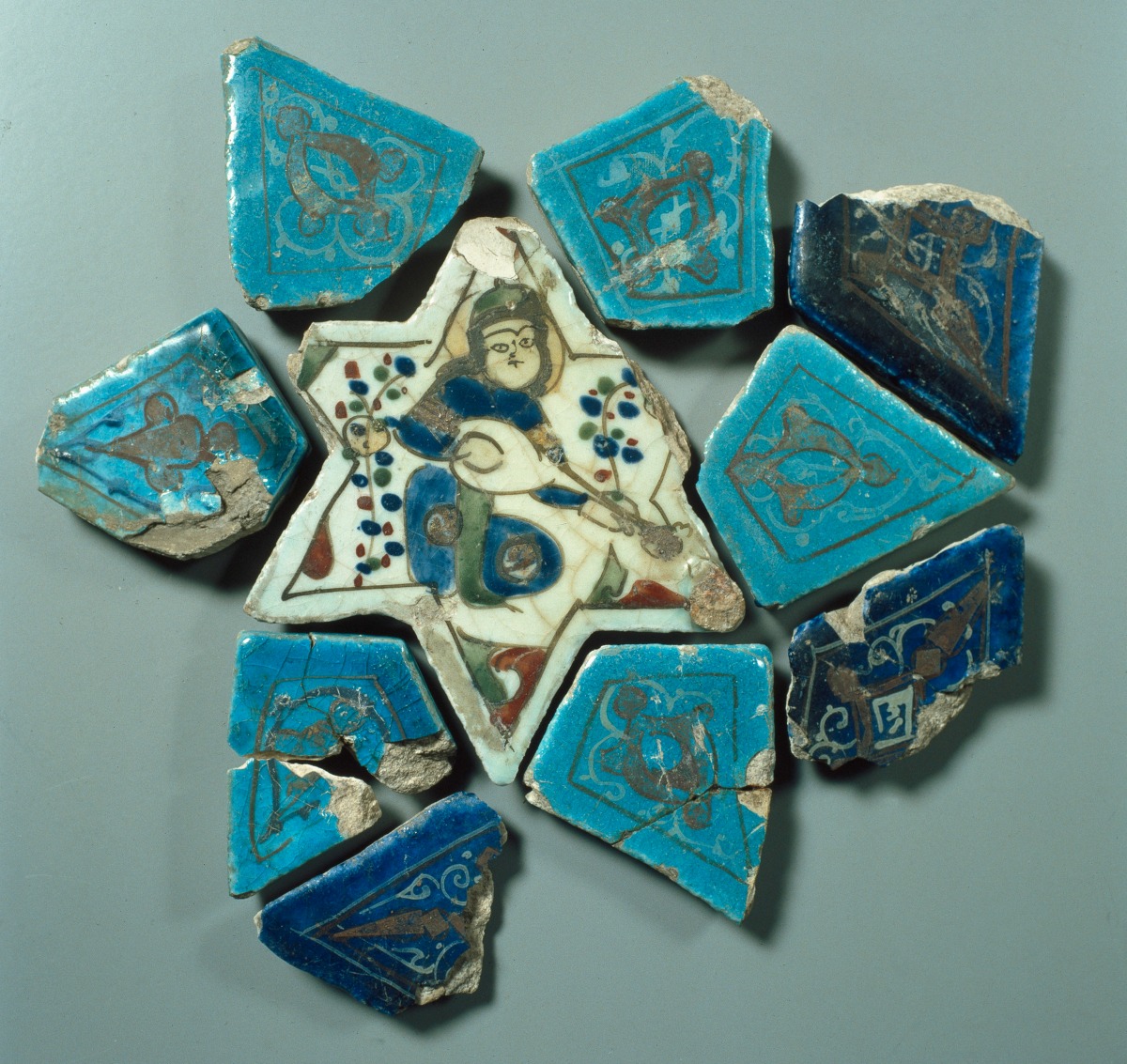In contemporary Turkey, the saz or bağlama, being a member of a large family of long-necked lutes called tanbûrs, is the core instrument of all folk musical ensembles and orchestras and a popular instrument in the arabesk, entertainment, and pop music in Turkey. The bağlama also plays an important role during the ceremonies of the heterodox sects of the Alevî and Bektaşî and among the âşıks, the Anatolian wandering poet-musicians, to accompany their partly religious repertory. The bağlama plays furthermore an important role in musical education to teach folk-music theory, notation, performance, and teaching of acoustics and instrument construction. Its importance is also testified by the fact that musicians, such as Arif Sağ, Musa Eroğlu, and Erdal Erzincan, play the bağlama as solo instrument on national and international concert stages.
The long-necked tanbûr, which appeared in literary and iconographic sources during the Sâsânian era (c. AD 224-651), diffused into the various musical traditions along the Silk Road, resulting in a variety of closely or distantly related tanbûrs with two or more, occasionally doubled or tripled courses, a varying number and variously tuned frets, each having its own characteristic sound, playing technique, and repertory. Similar or identical instruments are also known by other names, such as saz or bağlama, dotâr or dutâr, setâr, dömbra, and damburâ (FIGURE 1).
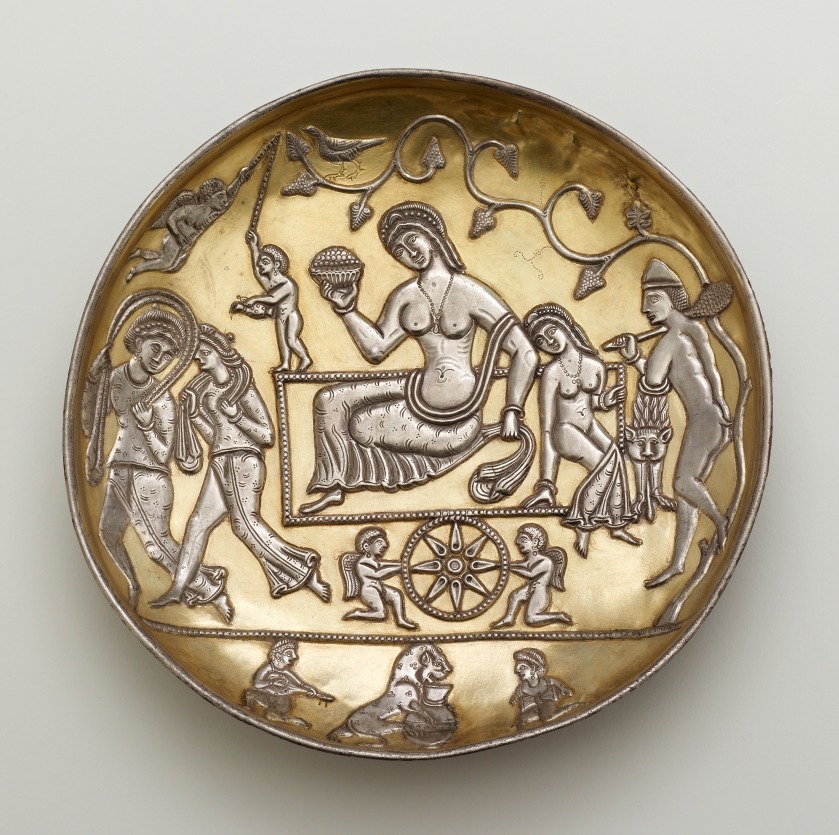
The tanbûr arrived with the Seljuks in Anatolia in the eleventh century or even may be before. Possible intermediaries in the development of the Turkish saz instruments are the by Abd al-Qâdir Ibnu Ghaibî al-Marâghî in his book Maqâsid al-Alhân (The meaning of melodies, early fifteenth century) discussed tanbûr-i şirvânîyân (the tanbûr of Shirwân, located in the north of Azerbaijan) and the tanbûre-i türkî (the tanbûr of the Turks). The tanbûre-i türkî had, compared to the tanbûr-i şirvânîyân, a smaller pear-shaped body, a longer neck and two or three strings (FIGURE 2). Saz is a Persian word meaning musical instrument. It appeared for the first time in a work by Nezami van Gandja (1141-1209), one of the greatest poets in Persian poetry. In Anatolia we come across the word saz in the fifteenth century as a name for the tanbur of the travelling poet singers, the âşık, who were also called saz şaileri, poets with the saz.

The origin of the name bağlama is still unknown. It could have been derived from the verb bağlamak (Turkish for to bind), the tying of frets around the neck or strings to the tuning pegs. The description of a saz with the name bağlama appeared in the second half of the 18th century in several European writings. Histoire générale, critique et philologique de la musique (1767) by Charles-Henri de Blainville (1711-1769), Reisebeschreibung nach Arabien und andern umliegenden Ländern (1774, 1778) by Carsten Niebuhr (1732-1815), and Essai sur la musique ancienne et moderne (1780) by Jean Benjamin de Laborde (1734-1794), who was sentenced to the guillotine during the French Revolution. De Blainville and Niebuhr were probably the sources of de Laborde. The bağlama was a small sized lute compared to the other lutes on the engravings of de Blainville, Niebuhr, and de Laborde (FIGURE 3).

A few decades later we find the name bağlama as tanbour baghlama in another European writing Description historique, technique et littéraire des instruments de musique des orientaux of 1823 by Guillaume André Villoteau. Villoteau, who stayed in Cairo from 1799 until 1803 as a member of Napoleons Egypt-expedition, discussed several tanbûrs, which were mainly played by Turks, Jews, Greeks, and Armenians. In Lane’s time (1830s), tanbûrs were still ignored by native musicians in Egypt and only played by Greeks and other foreigners (FIGURE 4).
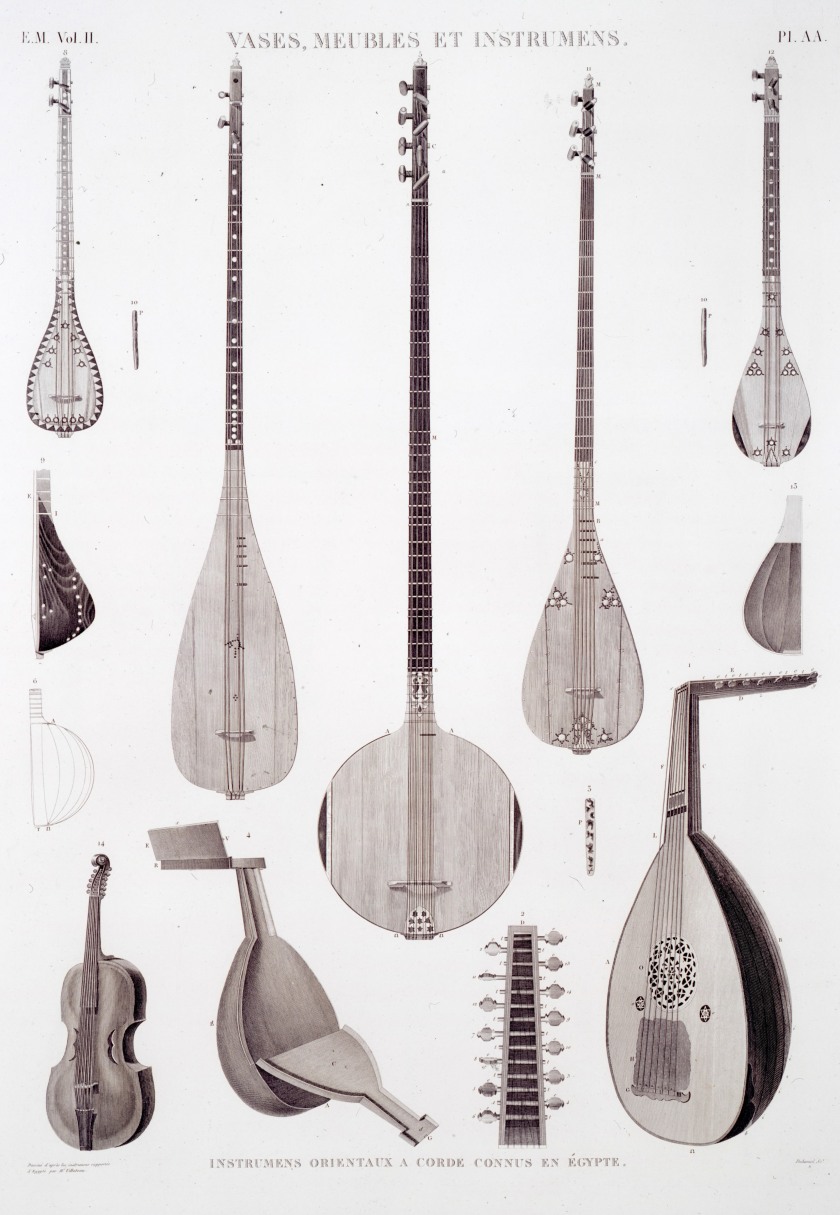
We know from the Seyâhatnâme of Evliyâ Çelebi that sazs, which travelled with the Ottomans to the Middle East and the Balkans, were present at the Ottoman court and in the Turkish cities. Literary and iconographic sources as well as surviving instruments to reconstruct the history of the saz in the rural areas of Anatolia before the 20th century are scarce or absent. The separation between urban and rural culture was mirrored by the sophisticated courtly and urban sazs and the simple rural sazs, a situation that only increasingly changed after the establishment of the Republic of Turkey in 1923.
The proclamation of the Republic of Turkey in 1923 in Ankara had a major impact on the musical traditions and musical instruments of which the modernized and standardized saz became the most important instrument. In the 1930s musicologists started to construct a theory of folk music parallel to that of the Ottoman makam tradition. A body of modal structures, instrument tunings, plectrum movements, and rhythms were established through collection and notation inseparably linked to the saz. Moreover, the number of tied-on movable frets was, in imitation of the Ottoman tanbûr, increasingly expanded to create a larger tonal range. An earlier example of this practice can be found on a drawing of a saz from the Tefhîmü’l Makamat fi Tevlîd-in Neğamât (The concept of the makams in the making of melodies, mid-18th century) of Kemânî Hızır Ağa.
Around 1940, the number of frets further increased, a development in which Mahmut Ragıp Gazimihâl (1900-1961) and Muzaffer Sarısözen (1899-1963) played an important role. This development took place around Radio Ankara and aimed to reform the music and musical instruments of the many regions, each with their own characteristics, into a coherent whole. For that purpose, choirs and orchestras were established, which performed uniform folk music on standardized sazs like those of Radio Ankara and Radio Istanbul.
Since the 1950s it became increasingly customary, starting in radio circles, to use the name bağlama instead of saz as a generic name for saz instruments. From literature we learn, however, that the traditional bağlama of Anatolia was a small saz. It is therefore obvious that not the small bağlama, but a larger saz was used to expand the number of frets. In contemporary Turkey, bağlama and saz are still used alternately.

Due to the modern entertainment industry and the changing taste of the audience after 1960, better trained musicians developed virtuoso playing techniques and set higher demands on technical and artistic issues such as the timbre and sound volume of their instrument, the method of stringing, and the number of frets and their arrangement on the neck. Around 1970 there was still a great variety in the number of frets and their tuning. Nail Tan concluded in Bağlama yapımı (Bağlama construction) that generally seventeen frets were used for the octave, but that the number of frets, among which non-diatonic ones, and their position on the neck was not yet standardized. Since second half of the 1980s, there seems to be some agreement. Sabri Yener in Bağlama öğretim metodu (Bağlama teaching method) and Irfan Kurt in Bağlamada düzen ve pozisyon (Bağlama tuning and vertical technique) both established seventeen frets in the octave, including five non-diatonic frets. Cafer Açin (1939-2012) established in Bağlama. Yapım sanatı ve sanatçıları also seventeen frets in the octave for the long-neck bağlama as well as short-neck bağlama (FIGURE 5).
The development of virtuoso playing techniques consisted of an increasing combination of vertical and horizontal playing techniques on the bağlama. In order to make an effective use of its vertical possibilities, the neck had to be shortened. By constructing a more pear-shaped bowl it was possible to lengthen the neck inwardly. In this way, the neck could be kept relatively short keeping the necessary space for the frets (FIGURE 6).
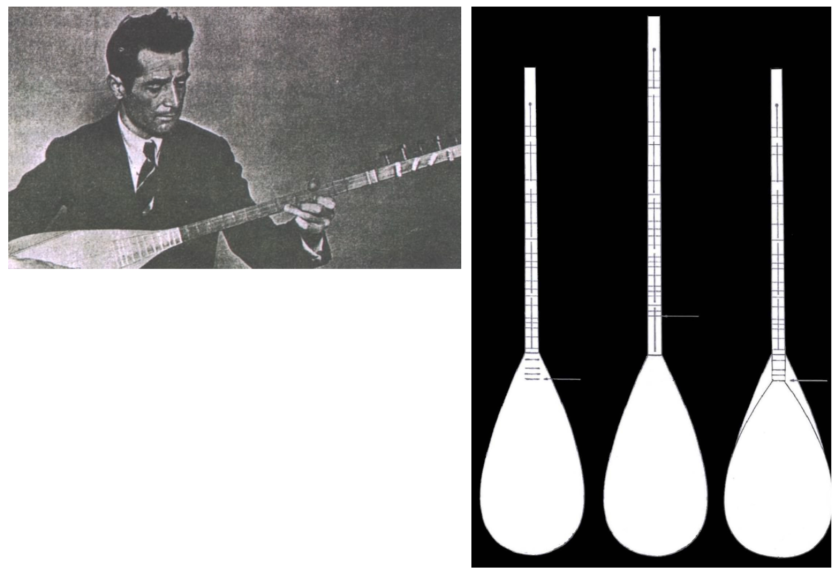
Modern entertainment required, furthermore, the amplification of the sound. The bowl was therefore changed from a small U-shape to a larger and deeper U-shape with a soundhole (kafes) under the tailpiece (tel bağlama takozu) or, sometimes, in the soundboard. The soundboard changed from slightly arched and composite to a flat one made of a singular sheet of wood. For constructional reasons, the characteristic straight pegbox of the saz was replaced by a slightly angled attached pegbox. Moreover, on the first, third, and sometimes second course one of the strings was replaced by a so-called ‘bam teli’ or ‘octave’ string (brass-wrapped string), which was introduced towards the end of the 1950s by Neşet Ertaş (1938-2012) who was probably the last of the great bozlak (songs of agony) poet-musicians. These changes increased the soundvolume and changed the timbre. Moreover, the bağlama was amplified with electronic devices to facilitate playing in clubs or concert halls (FIGURE 7).
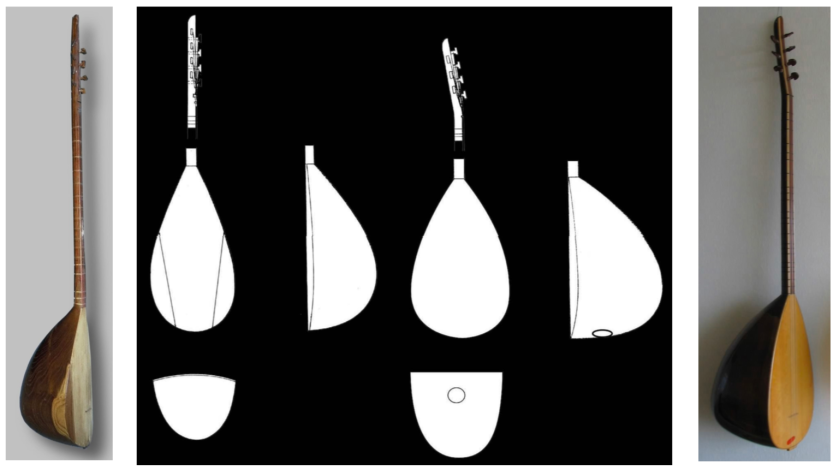
The ongoing development of virtuoso playing techniques, combining the traditional horizontal playing techniques with vertical playing techniques, fuelled the development of the short-necked bağlama, being actually a long-necked bağlama with a shortened neck, an instrument suiting the combining of vertical and horizontal playing techniques. To distinguish the long-necked bağlama from the short-necked bağlama, the long-necked bağlama was called unzun saplı bağlama, the short-necked bağlama kısa saplı bağlama. The first experimental versions of the short-necked bağlama emerged after 1960. Musicians were, before Arif Sağ asked the luthier Kemal Eroğlu to develop a short-necked bağlama, not very interested in the short-necked bağlama. According to Kemal Eroğlu, the short-necked bağlama was derived from the long-necked saz/bağlama. According to Arif Sağ, however, the short-necked bağlama was not a new development but an older type saz type with a short neck. Some agree that there are certain similarities with the saz of the Alevî dedes.
The short-necked bağlama became after 1980, mainly under the impulses of Arif Sağ, a very popular instrument, particular in combination with the şelpe and parmak vurma technique (see accompanying video of Erdal Erzincan). An example is his virtuoso Teke Zotlaması, which was also played by Talip Özkan (1939-2010) on the long-necked bağlama as well as cura bağlama. Talip Özkan started in the 1960s to combine the traditional horizontal playing technique with vertical playing techniques on the long-necked bağlama tuned to the bozuk düzeni tuning, a tuning facilitating both techniques (FIGURE 8).
- Figure 8. On the left, Arif Şağ playing şelpe on the kısa saplı bağlama during a concert in the Tropeninstituut in Amsterdam. Foundation Kulsan, Amsterdam. On the right, Talip Özkan playing a long-necked bağlama combining horizontal and vertical playing techniques.
Many folk musical genres can be played on the long-necked bağlama because it can be tuned in various ways. The short-necked bağlama has, on the other hand, a higher sound volume and can, because of its shorter neck and closely spaced frets, be played ‘easier’ and faster making use of all the three courses. Despite its popularity the short-necked bağlama did, however, not displace the long-necked bağlama.
Modernization and standardization resulted, furthermore, in the 1980s in the in the bağlama family (bağlama ailesi). Within the bağlama family different size categories can be distinguished, although no single classification is in general accepted and there are, moreover, also intermediate forms. A possible classification of the bağlama family, from small to large, is the cura, the short-necked bağlama (kısa saplı bağlama) and the long-necked bağlama (uzun saplı bağlama), the tanbura, the divan sazı, and the meydan sazı. The establishment of a nomenclature of the saz/bağlama family still has to be undertaken (FIGURE 9).
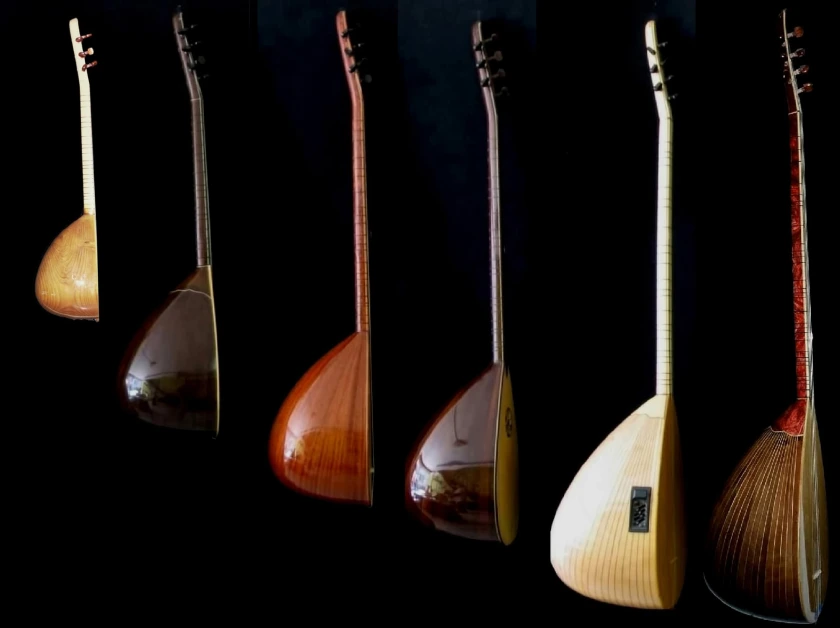
The systematic use of all three string courses and making a more effective use of the bağlama düzeni not only resulted in the short-necked bağlama but also initiated the development of instruments such as the dört telli bağlama (four course bağlama) and Oğur sazı, developed by the luthier Kemal Eroğlu after an idea of the musician Erkan Oğur. Both instruments are a continuation of the development of vertical and harmonic playing techniques (FIGURE 10, left).
Since the first six-stringed prototype from 1991, more prototypes were built like the thirteen-stringed and six-stringed Oğur sazı. In the meantime, various versions of the Oğur sazı were built by among others the musician and luthier Engin Topuzkanamış (Izmir) for other musicians like Efrén López and Guillermo Rizotto in Spain and Gilad Weiss in Israel (FIGURE 10, right).
- Figure 10. On the left a four-course dört telli bağlama by Murtaza Çağır and ten-stringed Oğur sazı by Engin Topuzkanamış. On the right Engin Topuzkanamış playing a six-stringed version of the Oğur sazı in his workshop in Izmir.
An example of how the bağlama can inspire new forms is the divane of Yavuz Gül. Looking for a larger volume than the divan sazı, Yavuz Gül (Izmir) developed the divane, a family of hybrid instruments inspired by the long-necked bağlama and ‘ûd/lauta. The divane family consist of the efe divane, baba divane, divane deli, and the bass divane (FIGURE 11).
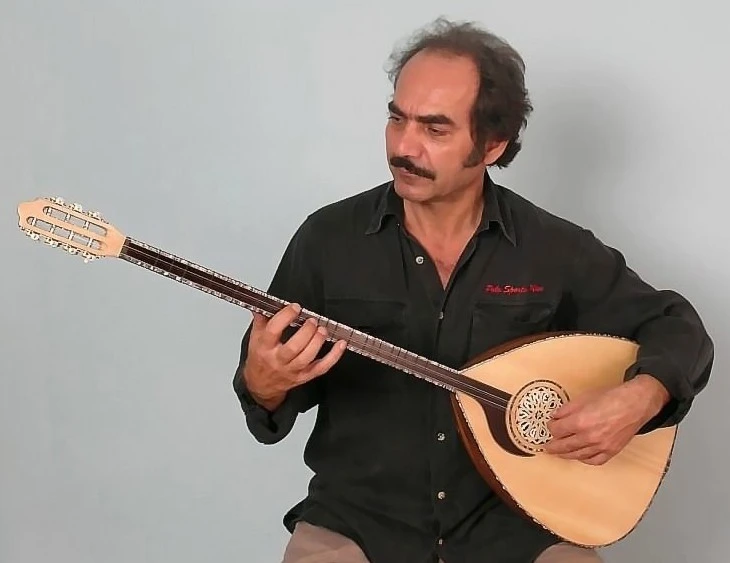
The exploration and development of vertical and harmonic playing techniques and a theory of Turkish harmony, for which the bağlama provides a model, will remain an important issue within Turkish folk music, notwithstanding attempts to standardization. Instrument makers do respond to the changes in the musical practice. This principle has dictated the evolution of music and instrument making for centuries.
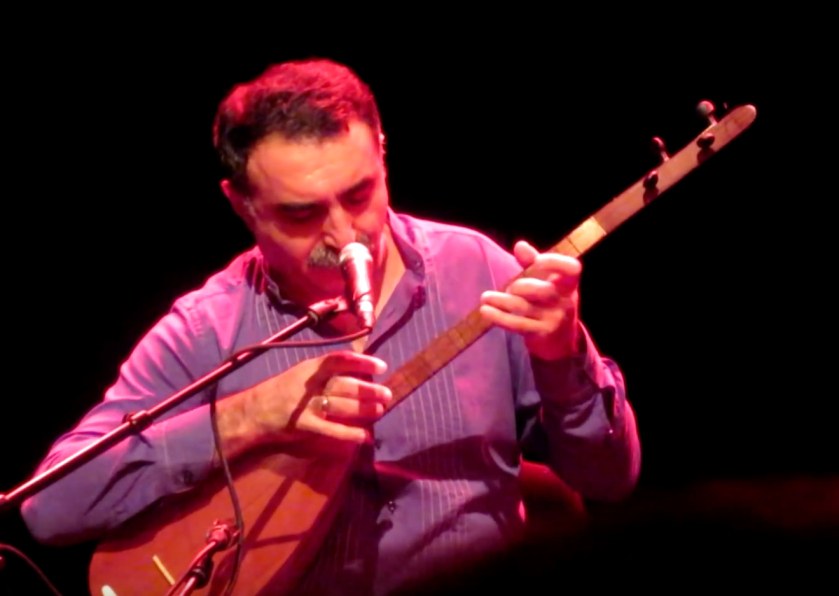
Musical instruments are constantly changing and there is always room for improvement, innovation, and evolution. New bağlama types, of which the construction, the number of frets and their tuning, number of strings and their tuning, and playing technique vary, will therefore continue to evolve (FIGURE 12).
Further Reading
Bates, E. 2011. Music in Turkey: Experiencing Music, Expressing Culture (Global Music Series). Oxford: Oxford University Press.
Conway Morris, R. 2001. Bağlama, in S. Sadie (ed.) New Grove Dictionary of Music and Musicians 2: 469. London: MacMillan Press Limited.
Hassan, S.Q., R. Conway Morris, J. Baily and J. During 2001a. Tanbūr, in S. Sadie (ed.) New Grove Dictionary of Music and Musicians 25: 61-62. London: MacMillan Press Limited.
Sayce and T. Crawford 2001. Lute, in S. Sadie (ed.) New Grove Dictionary of Music and Musicians 15: 329-363. London: MacMillan Press Limited.
Spector, J., R. At’Ajan, C. Rithman C and R. Conway Morris 2001. Saz, in S. Sadie (ed.) New Grove Dictionary of Music and Musicians 22: 361-362. London: MacMillan Press Limited.
Stokes, M.H. 1993. The Arabesk Debate. Music and Musicians in Modern Turkey. Oxford: Claredon Press.
Zeeuw, J. 2009. De Turkse Langhalsluit of Bağlama. Amsterdam.
Zeeuw, J. 2019. Tanbûr Long-Necked Lutes along the Silk Road and beyond. Oxford: Archaeopress.
YouTube
Arif Sağ: https://www.youtube.com/watch?v=FPrTu3AWfuM
Talip Özkan: https://www.youtube.com/watch?v=ha5mAX1WaMM
Neşet Ertaş: https://www.youtube.com/watch?v=7yQI2mUX7Rc
Erdal Erzincan: https://www.youtube.com/watch?v=__ZGmCkB58I
Sincerest thanks to Hans De Zeeuw for providing this article for the Archaeopress Blog.
Hans’ latest book, Tanbûr Long-Necked Lutes along the Silk Road and beyond (Archaeopress, 2019) is available:
Paperback, ISBN 9781789691696, £40
PDF eBook, ISBN 9781789691702, from £16+VAT
Available here:

